Navigation:
→ Diamond Certification
→ Anatomy of a Diamond
→ The Evolution Of Diamond Cutting
Deciding on which metal to choose for your jewellery is a key decision in the process. Many factors have to be considered as all metals differ in their properties. We have broken down these factors for you.
Lifestyle
Lifestyle is a key element to considering when deciding, for example is the wearer has a more ‘hands on’ career, choosing a softer metal such as gold might not last the wearer as long as a more durable metal like platinum would. If the recipient is more prone to wearing white jewellery over gold jewellery then considering the natural white occurring metals would be a good starting point.
Colours
Creating the perfect match between metal colour and gemstone colour is integral to your perfect piece. A colour clash between a metal and a gemstone can ruin the design and will not be as impactful as a complimenting combination.
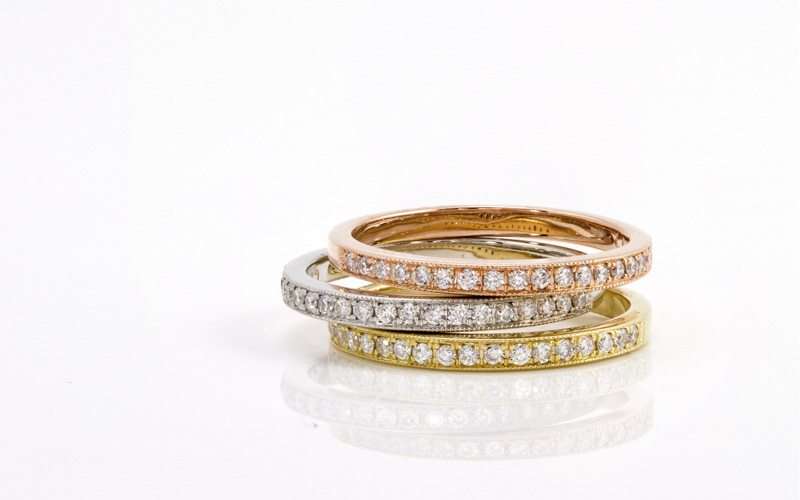
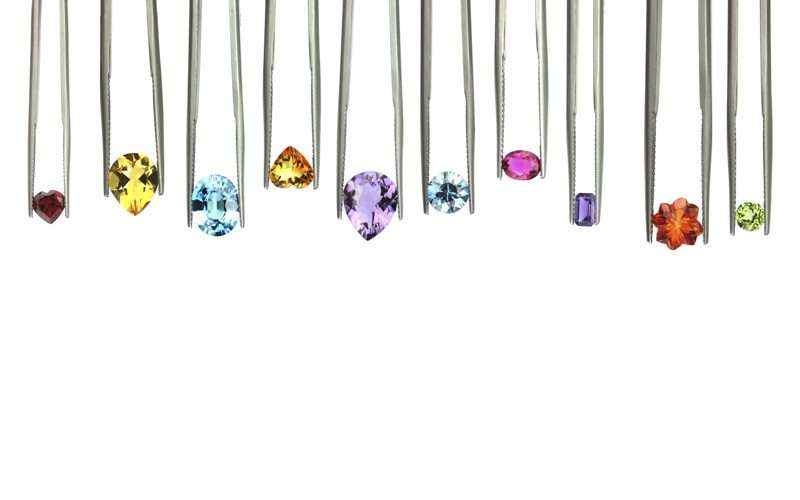
Style
The style of ring can be a determining factor in the decision process, a piece that is quite heavy produced in a dense metal like platinum will be very weighty on the hand and if the recipient has delicate hands it won’t be a good choice, so considering a less dense white metal like palladium would be a great option to bring the weight down. However, a delicate piece in a soft metal can cause maintenance problems due to the lack of durability of the metal and lack of density within the metal so a more durable metal should be considered to assure strength within the piece.
Price
Budget is another key factor in determining which metal is the best metal for you. If your budget is strict and you can’t afford to have your gemstone set in a metal like platinum then considering the other white options like palladium or white gold is something to look into. Metal prices do fluctuate and as all prices of mounts for engagement rings are dictated by weight, it is common that the price can fluctuate too.
What is Platinum?
Platinum has grown increasingly popular over the years due to its natural white beauty and durability. The rich white colour of Polished platinum makes it a popular choice for engagement rings, retaining its natural white lustre and its purity of 95% means it’s a hypoallergenic metal with minimal cases of allergic reactions.
Being the most prestigious option for a ring, Platinum is naturally heavier than over metals, (approximately 50% heavier than equivalent white gold) but it’s still mixed with alloy metals to ensure its strength and durability. Its high density makes it the most secure setting for your gemstones.

Pros
- Most durable metal available
- Heaviest & densest metal you can choose
- Will withstand everyday wear
- Perfect for delicate pieces
- Natural white colour will always be preserved
- Hypoallergenic due to its purity
- Natural white colour compliments gemstones
- Easy to work with
Cons
- Genuinely the most expensive metal
- Might not be suitable for pieces of a substantial size or weight due to the metals high density
Care
Maintenance of all metals is down the lifestyle the wearer has. In the case of Platinum, due to its high durability the metal will naturally keep its white lustre but over time a slight sheen might develop on the surface of the metal which can always be polished by a professional jeweller to restore it back to its full lustre.
What is Palladium?
Palladium is just as naturally white as Platinum, but it is typically less expensive. Palladium rings are composed of 95% pure palladium which means they do not contain the metals that cause silver to tarnish.
Like Platinum it is tarnish resistant and naturally hypoallergenic making it a great option for someone who is sensitive to other metals but have their heart set on a white metal.
Palladium is a lighter material than most other metals which make it a popular choice for people who do not wear jewellery often and find heavy rings too uncomfortable. With the increase in the price of gold and platinum, palladium is one of the best choices for those with a lower budget who don’t want to sacrifice quality or beauty.
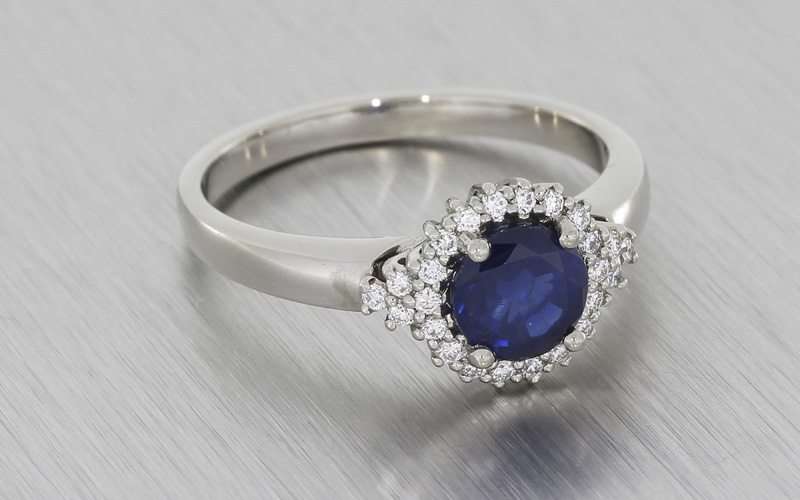
Pros
- Less expensive than platinum
- Natural white colour
- Hypoallergenic, due to its purity
- Natural white colour compliments gemstones
Cons
- Difficult to work with (resizing)
Care
Just like Platinum, due to its natural white appearance, Palladium will sustain its white lustre during wear. After long periods of wear, a surface layer with the appearance of a slight sheen will appear which can be removed by a professional jeweller with a full polish to bring the metal back to life.
What is White Gold?
White Gold is a beautiful and popular choice for jewellery available in 9k, 14k and 18k. the higher the Karat, the higher percentage of pure gold within, therefore the softer the metal. Even though gold is a naturally occurring yellow metal, it is mixed with white alloys to produce a whiter colour. Typically, it is mixed with zinc, silver or palladium to give the metal its white colour and is then plated with rhodium – a metal related to platinum – to give an even whiter appearance to the metal that similar to Platinum and Palladium.

Pros
- A highly malleable material
- Less expensive than platinum
- Easy to work with (resizing)
- White colour wonderfully compliments all gemstones
Cons:
- A naturally softer metal than Platinum
- Natural yellow hue will appear over time due to everyday wear
- The cost to re-rhodium plate accumulates over the years
Care
The rhodium plating will tend to wear off and reveal the yellowish hue of the white gold over time due to its 75% yellow gold content. Plating will have to be repeated every 12-18 months, depending on lifestyle.
What is Yellow Gold?
Yellow gold has always been one of the most popular choices for jewellery. Its warm tone compliments all skin tones and its natural yellow colour stands the test of time. While yellow gold is often thought of as pure, it is commonly mixed with other alloys such as zinc and copper. The higher the karat amount, the higher the gold content within the metal but the softer the metal. Yellow gold rings make a lovely choice for modern and vintage inspired designs. Also being the most malleable of all the precious metals means it is a very easy material to work with.

Pros
- Very classic
- Natural yellow colour will always stay present
- Easy to work with (Resizing)
- Highly malleable material
Cons
- A naturally soft metal
- Gets thinner and more worn down over time
- Colour varies depending on karat
Care
Yellow gold over time will scratch and dent due to its natural softness, so will need to be cleaned and polished by a professional jeweller frequently depending on lifestyle.
What is Rose Gold?
Often referred to as red gold or pink gold, rose gold gets it colour from adding copper alloys to yellow gold. It is extremely popular within the jewellery industry. The warmth of rose gold jewellery is flattering for any skin type. A higher karat rose gold will have more gold in it and therefore look slightly less pink than a 14k rose gold.
Wedding bands in rose gold for both men and women are becoming more common as well, for the non-traditional, yet stylish couple.
Durability is another consideration to keep in mind when comparing Rose Gold vs Yellow Gold or White Gold. Incredibly, this softly romantic coloured gold is the strongest of the three, as copper is very sturdy and the resulting alloy is tougher than yellow or white gold

Pros
- More durable than yellow or white gold
- Warm pink colour retained over time
- Compliments all skin tones
Cons
- Not hypoallergenic, due to copper alloy
- Doesn’t compliment all gemstones
- Colour varies due to karat
- Can be difficult to work with (Soldering)
Care
Naturally rose gold will scratch due to everyday wear. Your lifestyle will dictate how frequently you will need to have your rose gold jewellery re-polished. Taking your piece to a professional jewellery for a clean and polish will bring your jewellery back to life.
Thinking of mixing metal?
If you’re stuck deciding between platinum and gold, incorporating both metals into your bespoke piece could be the answer. It’s become increasingly popular to combine two colours of metal within your piece to add an even more personal look. Complimenting the clean whiteness of a metal like platinum with a bold yellow or rose gold will add to your bespoke piece and really help you create a piece of jewellery that will stand out.
A common design is to have the contrast of the mixed metals incorporated into a halo engagement ring with a white metal band accented by a yellow or rose gold halo surrounding your centre gemstone. This level of customisation allows your personality to be translated in to the piece along with your choice of gemstones helping you create a perfectly unique piece.
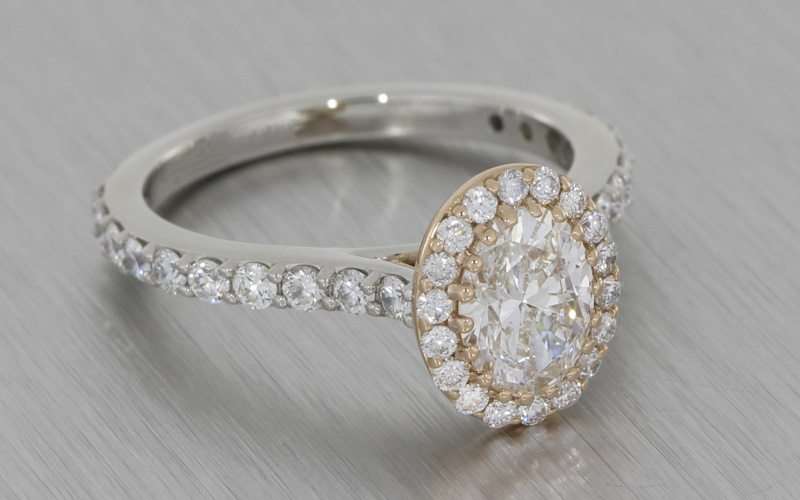
What is Hallmarking?
Hallmarking is an official stamp of quality guaranteeing that you are getting the exact purity of metal that you have purchased.
Here at Durham Rose we send your pieces to the trusted Sheffield Assay office for certification and hallmarking. Other locations for hallmarking are in Edinburgh, London and Birmingham each represented differently in the hallmark by distinguishing symbols.
Hallmarking is a necessary process that all jewellery manufacturers are obliged to do and this is an important element of the production process that ensures quality and certifies the value of your ring. This is necessary for some insurance companies and for ring valuations.

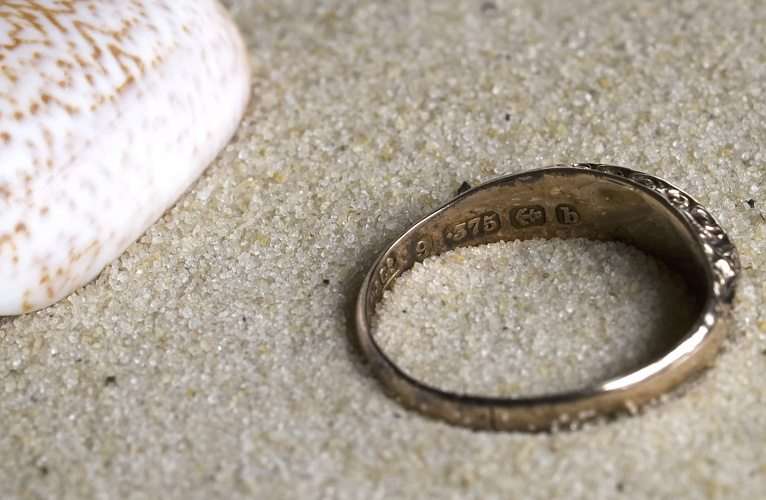
Understanding your Hallmark
Your ring will be marked with a number of symbols which are;
- Durham Rose Sponsor’s Mark: formally known as a Maker’s Mark
- The Standard Hallmark Mark: demonstrating the standard of finesse, i.e. the purity of the precious metal content in parts per 1000. For example, 18 carat gold is 750 parts per 1000 by weight
- The Assay Office Mark: showing which Assay Office tested and marked the item – we use the Sheffield Assay
- The Date Mark: defined by a stamped letter shows the year in which the article was hallmarked
This is what this information would look like on the inside of your piece;
Titanium
Having become increasingly popular within the jewellery industry over the last few years, Titanium jewellery is high in demand. Its durability and affordability is very appealing to the consumer but this durability and strength hinders its manufacturing possibilities. With titanium being such a strong metal it’s very difficult for detailed titanium pieces to be produced as its very hard to manipulate into intricate desired shapes. Simpler designs are possible using Titanium but due to its difficulty in processes such as resizing, we do not feel Titanium is a metal to recommend as one of the metals for your bespoke pieces.
Tungsten
Another metal becoming increasingly popular is Tungsten. Once again the durability and affordability of this metal are sought after properties for consumers. Similar to Titanium and its properties, the high level of strength creates difficulties during the manufacturing process which does not allow designs of intricate detail to be produced as it’s a hard metal to manipulate. Sizing rings made of Tungsten is also very difficult to do and will not be cost effective for the consumer.











